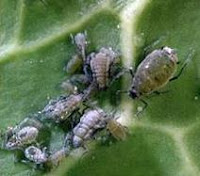.
 American Cockroach
American CockroachThe American cockroach is one of the hardiest species of cockroaches. Unlike most other cockroach species, the American cockroach can fly and is also attracted to light.
 Aphids
AphidsAphids are small insects found throughout temperate regions of the world. They parasitize a variety of wild and commercially important plants by sucking out plant fluids. Because aphids exude a sweet, sticky fluid that can be used by certain species of ants, herds of aphids are often found guarded and tended by ants.
 Blue Damselfly
Blue DamselflyAfter mating, blue damselflies deposit their eggs in water. The eggs hatch and develop into an aquatic larval form, which eventually leaves the water, undergoes metamorphosis, and changes into an adult.
 Caterpillar
CaterpillarThe larva of a butterfly or moth, known as a caterpillar, has a plump cylindrical body and chewing mouthparts. Most caterpillars eat leaves or other parts of plants and grow rapidly, shedding their skin several times as they grow. The caterpillar of a death’s head hawkmoth, Acherontia atropos, is pictured here.
 Firefly
FireflyThe firefly, belonging to the family Lampyridae, is one of a number of bioluminescent insects capable of producing a chemically created, cold light. Both males and females can generate the light, which is believed to attract them to each other. The light is produced when two chemical substances created by the firefly, luciferin and luciferase, come into contact with oxygen.
 Forager Ant
Forager AntA forager ant searches for food among blades of grass in South Africa’s Karoo National Park.
 Fruit Fly Laying Egg
Fruit Fly Laying EggThe small vinegar flies of the family Drosophilidae, commonly called fruit flies, have been exceptionally useful in scientific research. Their short reproductive cycle (a new generation of adults develops in only two weeks) and uncomplicated genetics make them ideal subjects for studies of heredity. This fly lays its eggs in rotting fruit and therefore does not need the stiff, sharp ovipositor that other fruit flies use to drill into fruits and stems.
 Great Diving Beetle
Great Diving BeetleThe great diving beetle has adapted to an aquatic environment. A voracious predator, the diving beetle feeds on tadpoles, small fish, and other insects and their larvae. Not strictly limited to the aquatic environment, diving beetles are capable of flying from one pool to another.
 Hornet
HornetThe European hornet is the wasp Vespa crabro, common on the east coast of the United States, where it is also called the giant hornet. This wasp, introduced from Europe in the mid-1800s, constructs its nest of hexagonal cells inside hollow trees. Wasp nests are paper, made of partially digested wood and plant fiber. Hornets may emerge from their nests at night and cluster around sources of light. Like other wasps, hornets have a painful sting.
 Katydid
KatydidThe katydid gets its name from the characteristic sound made by males as they rub their wings together to attract females. It is a tree-dwelling insect in the grasshopper family. The katydid resembles a folded green leaf in both color and appearance and uses this mimicry to escape detection from predators. Pictured here is an insect of the scudderia species.
< more pictures >
